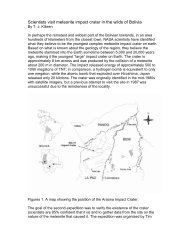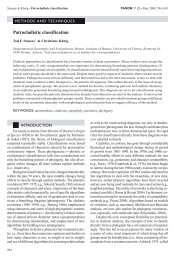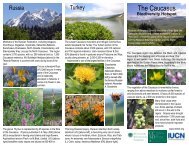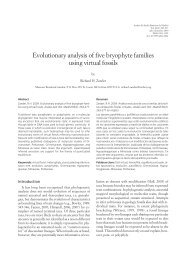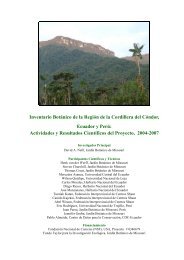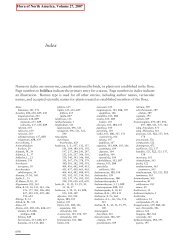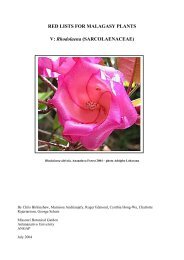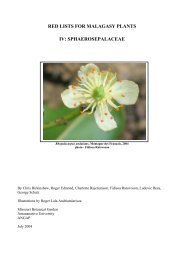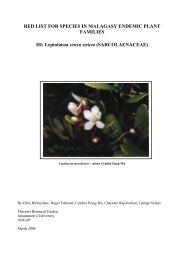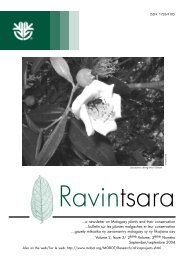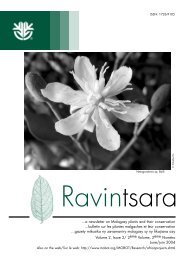phylogeny of campanulaceae s. str. inferred from its sequences of ...
phylogeny of campanulaceae s. str. inferred from its sequences of ...
phylogeny of campanulaceae s. str. inferred from its sequences of ...
Create successful ePaper yourself
Turn your PDF publications into a flip-book with our unique Google optimized e-Paper software.
564 Annals <<strong>str</strong>ong>of</<strong>str</strong>ong> the<br />
Missouri Botanical Garden<br />
all relatively divergent <strong>from</strong> each other morphologically.<br />
In terms <<strong>str</strong>ong>of</<strong>str</strong>ong> branch length, the taxa within<br />
the Rapunculus clade are much more divergent<br />
overall than the taxa within the Campanula s. <strong>str</strong>.<br />
clade (Fig. 2). Githopsis Nuttall and Heterocodon<br />
Nuttall are rather divergent in morphology <strong>from</strong><br />
each other, particularly that <<strong>str</strong>ong>of</<strong>str</strong>ong> the capsule (see<br />
McVaugh, 1945), but are probably closely related<br />
and have <strong>str</strong>ong boot<strong>str</strong>ap support (100%). They are<br />
sister to the remaining members <<strong>str</strong>ong>of</<strong>str</strong>ong> the Rapunculus<br />
clade. Most <<strong>str</strong>ong>of</<strong>str</strong>ong> these taxa are either Mediterranean<br />
or North American in di<strong>str</strong>ibution. The majority <<strong>str</strong>ong>of</<strong>str</strong>ong><br />
taxa within this clade have open, upright flowers<br />
that are rather stellate in form, and the capsule<br />
opens apically or medially by a pore, but there are<br />
conspicuous exceptions (see below). None <<strong>str</strong>ong>of</<strong>str</strong>ong> the<br />
taxa in the Rapunculus clade has calyx appendages.<br />
The irregular rupture <<strong>str</strong>ong>of</<strong>str</strong>ong> the capsule apex in Githopsis<br />
may represent a derived condition, but this is<br />
not to imply that <strong>its</strong> ance<strong>str</strong>al state was lateral (e.g.,<br />
it may be derived <strong>from</strong> an apical valvate condition<br />
similar to that present in the wahlenbergioid alliance).<br />
In Adenophora, Hanabusaya, and Campanula<br />
rotundifolia L. (the sole representative <<strong>str</strong>ong>of</<strong>str</strong>ong> the<br />
harebell group sampled, Campanula subsect. Heterophylla<br />
Fed.), the flowers are campanulate and<br />
nodding and the capsule opens basally. The inclusion<br />
<<strong>str</strong>ong>of</<strong>str</strong>ong> these taxa within the Rapunculus clade is<br />
surprising. Morphologically these taxa seem to be<br />
more closely allied to groups within the Campanula<br />
s. <strong>str</strong>. clade (e.g., C. latifolia and <strong>its</strong> allies in sect.<br />
Eucodon).<br />
When Githopsis and Heterocodon are removed,<br />
the remaining taxa <<strong>str</strong>ong>of</<strong>str</strong>ong> the Rapunculus clade have<br />
100% boot<strong>str</strong>ap support. Within this clade the Texan<br />
endemic annual Campanula reverchoni A. Gray<br />
is sister to all the remaining taxa, although support<br />
for this group is weak ( 50%). Within this clade<br />
there are several small groups with moderate to<br />
<strong>str</strong>ong support. The clade comprising Adenophora<br />
and Hanabusaya is <strong>str</strong>ongly supported (99%), although<br />
species relationships are largely unresolved.<br />
This confirms the close relationship between Hanabusaya<br />
and Adenophora suggested previously by<br />
Eddie (1997) and by Kim et al. (1999), and it tentatively<br />
suggests that Hanabusaya is closest to the<br />
two species A. stenanthina (Ledeb.) Kitagawa and<br />
A. paniculata Nannf. (sect. Thyrsanthe (Borb.)<br />
Fed.). Support for the clade uniting these three taxa<br />
is weak ( 50%). The remaining species <<strong>str</strong>ong>of</<strong>str</strong>ong> Adenophora<br />
form an unresolved polytomy, although there<br />
is weak support for a group consisting <<strong>str</strong>ong>of</<strong>str</strong>ong> A. himalayana<br />
Feer (sect. Pachydiscus Fed.) and A. lobophylla<br />
D. Y. Hong (sect. Microdiscus Fed.).<br />
The sister group to the Adenophora/Hanabusaya<br />
clade is only weakly supported, but it contains several<br />
well-supported smaller groups. These taxa are<br />
divergent morphologically and have a wide range<br />
<<strong>str</strong>ong>of</<strong>str</strong>ong> chromosome numbers. The group containing the<br />
serpentine endemic <strong>from</strong> the Balkans, C. hawkinsiana<br />
Hausskn. & Heldreich (2n 22), and Iberian<br />
endemics C. lusitanica Loefl. (2n 18), C.<br />
herminii H<<strong>str</strong>ong>of</<strong>str</strong>ong>fmanns & Link. (2n 32), and C. arvatica<br />
Lag. (2n 28), is <strong>str</strong>ongly supported (98%),<br />
while the clade with C. stevenii M. Bieb. (2n 32)<br />
and C. persicifolia L. (2n 16, 18) has a support<br />
value <<strong>str</strong>ong>of</<strong>str</strong>ong> 99%. The two morphologically divergent<br />
species, C. arvatica and C. rotundifolia (2n 34),<br />
are sister species with 77% boot<strong>str</strong>ap support.<br />
Campanula carpatica Jacq. (subsect. Rotula Fed.)<br />
does not appear to be as close to C. pyramidalis L.<br />
(2n 34), but it does resemble C. herminii <strong>from</strong><br />
the Iberian Peninsula. Campanula pyramidalis is<br />
part <<strong>str</strong>ong>of</<strong>str</strong>ong> the ‘‘isophylloid’’ group <<strong>str</strong>ong>of</<strong>str</strong>ong> species (e.g., C.<br />
isophylla Moretti, C. garganica Tenore, C. versicolor<br />
Andrews [not sampled], etc.), which is centered in<br />
Italy and the western Balkan Peninsula and is<br />
somewhat intermediate between the Phyteuma L./<br />
Asyneuma alliance and those species that could be<br />
considered as typically rapunculoid (e.g., Campanula<br />
carpatica, etc.) (see also Damboldt, 1965a).<br />
However, many species in this group hybridize<br />
freely, and numerous hybrids involving C. carpatica<br />
are known in cultivation (Lewis & Lynch, 1989).<br />
Thus, the ITS data suggest that this grouping is a<br />
natural one. Broader sampling would perhaps have<br />
helped clarify the positions <<strong>str</strong>ong>of</<strong>str</strong>ong> the ‘‘isophylloid’’ and<br />
Heterophylla groups.<br />
The Phyteuma clade includes morphologically<br />
similar species and has <strong>str</strong>ong boot<strong>str</strong>ap support<br />
(91%). Petromarula Vent. ex Hedw. f. is sister to<br />
all the other taxa, followed by Asyneuma japonicum<br />
(Miq.) Briq. The clade comprising Physoplexis<br />
(Endl.) Schur and Phyteuma has a boot<strong>str</strong>ap support<br />
<<strong>str</strong>ong>of</<strong>str</strong>ong> 81%, but relationships within this group are<br />
unresolved. The long branches in this clade (Fig.<br />
2) suggest these taxa are relatively divergent. The<br />
sister group <<strong>str</strong>ong>of</<strong>str</strong>ong> Phyteuma and closely related genera<br />
includes Eurasian genera such as Legousia Dur.<br />
and several diverse North American taxa, such as<br />
Triodanis Raf., Campanula divaricata Michx., and<br />
Campanula<strong>str</strong>um americanum (L.) Small. This<br />
clade is weakly supported with a boot<strong>str</strong>ap value <<strong>str</strong>ong>of</<strong>str</strong>ong><br />
less than 50%. Apart <strong>from</strong> Triodanis, which is<br />
sometimes considered to be congeneric with Legousia<br />
(McVaugh, 1945, 1948), these taxa are all rather<br />
divergent morphologically. In Asyneuma, Phyteuma,<br />
Petromarula, Physoplexis, the ‘‘isophylloid’’<br />
species such as Campanula pyramidalis, and the<br />
American taxa such as Campanula<strong>str</strong>um and Triod-





